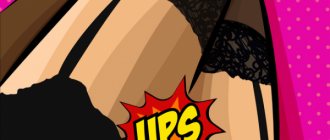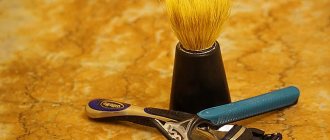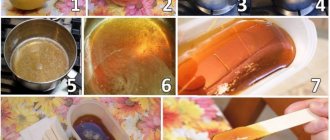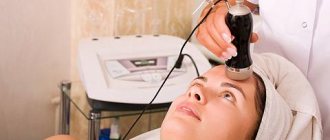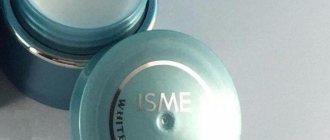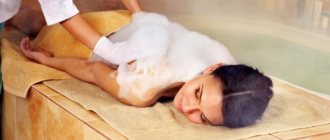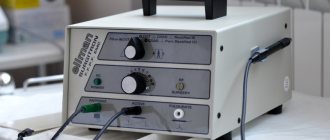There are many ways to lose unnecessary hair on the body, one of which is home photoepilation.
We will talk about the principle of operation of the method, the longevity of the effect and the possibility of application on various areas of the skin.
To properly carry out the hair removal procedure, carefully study the information provided.
Operating principle
Let's start with what this method is and what the effect of photoepilation depends on.
If you have heard about the principle of laser hair removal, then it will be difficult for you to distinguish it from photoepilation, since in both methods the removal of unwanted vegetation is carried out using light waves.
That is, a ray of light hitting the hair causes it to separate from the hair follicle and fall out. The laser also kills the hair follicle, so subsequent hair growth is not observed. Did you know ?
Hair is exposed to laser only at a certain moment of growth, namely: when the hair is 1-2 mm long and connected to the hair follicle, and not just to the walls of the follicle. However, there are many differences that are difficult to explain without going into detail about the entire action.
The first difference is a photoepilation device that emits light with a spectrum from 560 to 1200 nm. This means that several lasers are involved in the work at once. They are capable of removing hair of any color (except gray) from skin of any color.
The second difference is the quality of the procedure. A photoepilator is not able to remove all suitable hairs on the treated area at once. This is due to the operating principle of the laser system itself. Therefore, the number of necessary procedures for complete removal of vegetation almost doubles compared to laser hair removal.
The third difference also applies to photoepilation equipment. Due to the use of a large number of light-emitting elements, the range of action of the epilator increases. That is, the device covers most of the skin at one time, but this is also a disadvantage, which is described in the second paragraph.
The fourth difference (and the main advantage of photoepilation) is the time of the session. Since the work involves many elements that emit light, the duration of the procedure is reduced by 2-3 times compared to laser hair removal.
And the last difference is the price. On average, the price for this procedure is 1.5 times higher than for conventional laser hair removal.
In Europe during the Middle Ages, excess hair on the body was shaved off, and soft hair was rolled out with bread-wax balls.
Braun 7175
- area of application: legs, body, bikini area;
- epilation type - dry / wet;
- speed - 2;
- operating principle: tweezers (40 pcs);
- power supply - battery (operation up to 40 minutes), recharging from the mains (from 1.5 hours);
- number of nozzles - 2.
Even the name of the model - Braun 7175 Silk-epil 7 Wet&Dry - contains the principle of operation of a device that provides silky and beautiful skin. The epilator also supports dry and wet epilation, that is, the device can be used in the shower, in the bath, or simply on well-towel-dried skin.
Special tweezers with a patented coating effectively remove even the shortest hairs, less than 0.5 mm in length, and smart lighting allows you to carry out the procedure even more thoroughly due to the ability to see every hair on the body and evaluate the consequences of the procedure.
The epilator is equipped with a floating attachment for high-frequency massage, which relaxes the skin and makes epilation as soft as possible, including by following all the contours of the body, which ensures the comfort of manipulation, its effectiveness and long-lasting results in the form of silky and healthy skin. There is a well-thought-out system of “fingers” that capture even those hairs that fit tightly to the skin and guide them to the tweezers.
Charging the battery lasts for 40 minutes of autonomous operation, but recharging does not take too long - after just 1 hour the device is ready for use again.
The epilator is completely waterproof - even if placed in a bathtub filled with water, the device will continue to work without failures or damage.
How to choose the right photoepilator
Let's talk about choosing a device for photoepilation at home. Due to the fact that this procedure in clinics is quite expensive, and the number of procedures involves significant waste, choosing a “home” photoepilator is not only saving money, but also timely getting rid of hair.
Popular brands and approximate prices
When choosing a device for home photoepilation, first of all you need to pay attention to the list of manufacturers, maximum and minimum prices.
Major manufacturers of equipment for home use:
- "Babyliss";
- "Beurer"
- "Braun";
- "Panasonic";
- Philips;
- Remington;
- “Rio Beauty;
- Rowenta;
- "Silk'n"
Of these, two manufacturers can be distinguished that have the largest assortment - BaByliss and Philips.
The price range for hair removal devices is quite wide, so you can choose either the most economical option, which costs $27-30, or the most expensive, which costs $670-700.
Depending on the price, a device for home photoepilation can be portable or powered from the mains, equipped with a cooling system or additional lighting.
Advice !
Portable photoepilators capture a smaller area of skin and discharge quickly enough, so it is not recommended to buy a battery-powered unit unless there is a proper need. The kit may also include attachments for sensitive skin, removal of individual hairs, or for facial hair removal.
Restrictions after photoepilation
Photoepilation (contraindications and its consequences can be minimized by proper follow-up care) after the session for 3-4 days requires abstaining from:
- sunbathing;
- visiting a solarium, bathhouse, sauna;
- applying cosmetics to the treated areas.
You should not steam hair removal areas in a hot water bath or clean them with scrubs, gomages or peels. To prevent infection, you should not swim in open water. When going outside after removing facial hair, you must apply sunscreen with SPF greater than 30.
The effectiveness of home appliances on different parts of the body
The effectiveness of photoepilation at home is the main question that interests many girls reading this article.
The fact is that, as in the case of laser hair removal, it is worth considering many factors that affect the effectiveness of the procedure. It all depends not only on the high cost of the device, but also on the settings. You need to choose exactly the radiation interval and the power at which the hairs and hair follicles will be destroyed, and the skin will not be burned.
However, do not be afraid, since device manufacturers have foreseen the possible consequences and made the maximum power of photoepilators such that you cannot cause significant damage to yourself.
Therefore, after reading the instructions in detail, you will be able to compare your hair type with those offered in the catalog and set the settings correctly.
Now let's talk about certain parts of the body on which vegetation most often causes inconvenience.
Advice !
When removing hair from sensitive areas (bikini and face), use special attachments to ensure proper operation of the device. Bikini zones. The effectiveness of photoepilation in the bikini area is quite high, since in this area the skin is naturally very light, and the hairs themselves are quite dark, so the device works very well, removing unnecessary hair. The only thing worth focusing on is the duration of the session.
Since the skin in the bikini area is very thin, prolonged exposure to the laser can lead to burns, so carefully read the instructions for the photoepilator and do not exceed the described time limits.
Deep bikini areas. A deep bikini includes the pubic area and labia minora.
The only difference between deep bikini photoepilation and regular bikini is the number of light flashes required to achieve maximum effect. So, to remove hair around the contour of underwear, 6-30 pulses are enough, and to remove hair from the pubis and labia, you need from 30 to 90 flashes. Advice !
To achieve maximum effect when preparing for a summer trip to the sea, you need to start procedures at the end of winter. On the face. Excessive facial hair is a girl’s worst nightmare, since, unlike other parts of the body, the face cannot be covered with anything, and the maximum effect is expected from the procedure.
The photoepilator perfectly removes hair from the face, but the hair must be 1-2 mm long and not bleached. If these conditions are met, then you only need to carry out a 7-10 minute procedure to begin getting rid of hair.
It is worth remembering that photoepilation will be useless in areas with bleached hair, since they are not exposed to laser irradiation. That is why be careful and do not exceed the time limit for removing such vegetation, otherwise you will either overheat the device or damage the skin.
What is photoepilation? The principle of operation of the photoepilator
Photoepilation is a technology that allows you to remove hair using a light flash emitted by a special device - a photoepilator. The principle of its action is based on the ability of melanin (the pigment contained in the hair) to absorb light radiation and transmit it in the form of heat impulses to the hair follicles.
Photoepilation. Contraindications and consequences of the procedure
As a result, there is a sharp rise in temperature to 80°C, causing the death of the bulb, which ensures the viability of the hair shaft. An additional factor is blood clotting, which leads to a cessation of the supply of nutrients to the hair follicle. To get rid of unwanted hair, you need to undergo several procedures.
In some cases, the follicle is not completely destroyed, but the irreversible processes occurring in it slow down hair growth, reduce its thickness and degree of pigmentation.
The light flash only affects follicles in the active phase. On average, their number is no more than 30% of the total volume. After 3-5 weeks, the next 15-25% of the follicles “awaken”, which is reflected in the appearance of a new portion of hair. Thus, in order to free one zone from “vegetation”, it is necessary to carry out from 3 to 5 photoepilation sessions.
Preparation
We will tell you directly about how to do photoepilation at home, and what preparation needs to be done before performing the procedure.
Before hair removal, you need to visit a dermatologist so that he can determine your skin type and decide whether photoepilation can be carried out at the moment or not.
If the doctor gives a positive answer, we move on to the second stage, which involves reducing the hair length to 1-2 mm. To do this, we only use a razor; no other methods of removing vegetation are suitable. In order not to sit with a ruler, measuring the desired length, simply shave the desired part of the skin 1-2 days before the procedure.
After studying and charging the device, we cleanse the skin using a scrub or other products that do not contain abrasive particles (they have increased hardness). Before epilation, the skin must be clean and completely dry. This completes the preparation for photoepilation.
Impact on the health of women and men
Photoepilation is a safe procedure provided the specialist is highly qualified and there are no contraindications for the patient. To protect yourself from unexpected undesirable consequences, you should first visit a dermatologist and endocrinologist.
Particular care should be taken when removing hair from women on the face and deep bikini area. In men, such a sensitive area is the scrotum and perineum. Experts do not recommend photoepilation for very sensitive skin due to the high risk of scarring, irritation, allergies and age spots.
There is a myth that during photoepilation, heating of the lymph nodes and blood vessels occurs, leading to the development of pathologies and malignant neoplasms. This is especially true for the armpit and groin area.
This statement has no scientific basis, since heating occurs only in the upper areas of the skin, where the hair follicles and sebaceous glands are located. While the structural elements of the lymphatic system are located in the deeper tissues of the body.
How to do the procedure at home: features of the procedure
Let's look at how to properly do photoepilation at home in step-by-step instructions.
After the preparatory stage, turn on the device and bring it to the skin. The sensors must determine whether the settings are correct for your skin and hair type. If everything is normal, the indicator will light green or blue; if not, it will light red. When removing hair, the epilator must be moved horizontally or at an angle of 45° to achieve maximum effect.
When carrying out the procedure on sensitive areas, you should apply a special photoepilation gel, which diffuses light and reduces pain.
When the allotted time for the treated area is over, the photoepilator will emit a sound signal, after which you need to move the device to another part of the skin or end the procedure.
On average, in 50 pulses the epilator covers an area of 2.5 cm, which is worth considering when moving after a signal.
About the photoepilation procedure, how to do it at home and devices for this type of hair removal, watch this video:
It is worth remembering that for safety reasons you must wear protective glasses for photoepilation, otherwise you can seriously damage your eyesight.
Important !
Epilate away from reflective surfaces (mirror, glass, metal) so that the light beam cannot reach your face, head or eyes. Constantly monitor your sensations during the procedure. You should not feel severe pain or the absence of any irritants at all. In the first case, the beam is too strong, in the second, it is weak. A slight burning sensation, discomfort, sensation of rupture of the follicles in the skin - this is what you should feel during hair removal.
What should you do after IPL hair removal?
This is very important, so you should follow your doctor's advice to reduce the risk of complications. Typically, your doctor will advise you:
- application of antiseptic cream after treatment;
- do not sunbathe and try to minimize your time in the sun;
- Contact your doctor immediately if you notice any signs of blistering, infection, persistent pain, or pigmentary changes.
Recommended reading
- Intimate photoepilation is a way to get rid of unwanted hair in a delicate place once and for all
- What is the difference between photoepilation and laser hair removal - comparative characteristics
- IPL photoepilation: advantages and disadvantages of the procedure
- Does hair grow after photoepilation and how to avoid it?
Post-procedure care
After the procedure, it is recommended to apply a special cream that will soothe the skin and moisturize it. Next, use sunscreen (if your skin is not covered by clothing) for two weeks.
During the day after photoepilation, you should not take a cold or too hot shower, wear tight-fitting clothes that come into contact with the treated area, or use chemicals.
From the first to the last procedure (until the entire course is completed), you cannot go to the solarium, sunbathe on the beach, or remove hair in any other way (except with a razor).
If, after photoepilation, severe redness of the skin or burning sensation is observed, then Panthenol or other preparations for burns should be used.
Important !
Any cosmetics that are applied to the skin area during the entire course should not contain alcohol. It is worth adding that after photoepilation at home, you need to clean the device used of fat, cooling gel or hair. Pay attention to the life of the lamps used to produce the light beam. They have a short service life and require frequent replacement.
Possible consequences of the procedure and how to eliminate them
After the procedure, side effects of varying intensity may occur. This may be mild swelling, hyperemia, itching. Do not worry if the unpleasant sensations gradually subside within 2-3 days. Otherwise, consultation with a specialist is necessary.
Burning
The consequence of a cosmetologist's mistake can be burns, manifested in the form of burning, pain, redness, the appearance of crusts and blisters. In this case, applying Panthenol or Bepanten to the damaged areas will help. They have antibactericidal, anti-inflammatory and healing effects.
Swelling and peeling of the skin
Minor swelling and peeling of the skin after photoepilation indicates the individual sensitivity of the patient. If these phenomena are accompanied by itching, then it is worth taking antihistamines (Tavegil, Cetirizine, Kestin).
Pimples, red rash
The appearance of pimples and red rashes that are not complicated by a bacterial infection should not be a cause for concern. Small purulent inflammations can be treated with antiseptic creams such as Miramistin and Baneocin.
If inflammation of the follicles occurs at the treatment site, then you should consult a dermatologist rather than try to deal with the problem yourself.
How many sessions will it take?
The average number of sessions required to obtain a stable effect is 5-6. However, the procedures must be carried out strictly after a certain period of time, so that at the time of removal the hair is at the desired stage of growth.
Therefore, answering the question of how often photoepilation should be done during one course, it is worth citing statistical data: the procedure must be repeated every 3-4 weeks in order to destroy those 30% of hair that are ready for removal.
It is worth remembering that a second course of hair removal will need to be carried out after 7-8 months, otherwise the hair will gradually return.
Photoepilation was invented by Morgan Gusgavsson. In 1990, at a congress of dermatologists in Stockholm, a Swedish doctor and engineer told the world about his discovery - the possibility of using intense pulsating light technology in cosmetology.
Comparison of photoepilation with other types of hair removal
Photoepilation, contraindications and consequences of which in some cases do not allow this procedure, has several alternative procedures.
Laser hair removal
The principle of laser hair removal is based on hair removal by destroying hair follicles with a laser beam. As with photoepilation, the light wave is absorbed by melanin, heating and destroying the hair matrix, the blood and lymphatic vessels that feed it, as well as the sebaceous glands.
The most effective is a diode laser operating at a wavelength of 800 nm. It penetrates deeply into the skin and acts more precisely than its ruby and alexandrite counterparts. The main difference between photoepilation and laser is the ability to use light waves of different lengths.
Affecting hair in the active growth phase, in one session the laser destroys only 10 - 25% of its volume. Therefore, the full course ranges from 6 to 10 procedures with an interval of 3-6 weeks. The number of sessions and the break between them depends on the intensity of hair growth and the degree of pigmentation.
You can select the radiation power in accordance with:
- hair thickness;
- melanin level;
- pigmentation of the integument;
- impact zone;
- individual sensitivity.
Electrolysis
The principle of electrolysis is based on the destruction of the hair follicle by a short discharge of electric current. Hair deprived of nutrition becomes unviable and immediately falls out. In 1 session, only hairs that are in the active growth phase are removed. Therefore, such 5-6 procedures are necessary.
Advantages of this method over photoepilation:
- removal of all types of hair (gray, bleached, vellus);
- instant result (the rod falls out immediately after exposure to current);
- reducing the duration of each subsequent session;
- preservation of the effect for up to 5 years.
Disadvantages of electrolysis:
- soreness;
- duration of the procedure is 2-3 hours;
- multiple contraindications;
- high risk of burns;
- risk of scar formation at the site of removal of coarse hairs;
- the need for a rehabilitation period, during which crusts form on the skin;
- the likelihood of infection getting into wounds due to insufficient sterilization of instruments and disinfection of treated areas.
ELOS hair removal
The ELOS hair removal method combines the effect of light on melanin and an electromagnetic pulse on the follicle. The devices for the procedure are equipped with a cooling system, ensuring a painless process. In terms of efficiency, ELOS exceeds other methods by 30%. Therefore, on average, no more than 4 procedures are needed to remove hair.
Advantages of the technique:
- Can be used on any area of the body;
- painlessness;
- safety;
- effect on all hair types;
- minimal risk of burns and redness;
- possibility of hair removal on tanned and dark skin.
Disadvantages of the method:
- high price;
- presence of contraindications;
- Mandatory high qualification of the specialist performing the procedure.
At the moment, ELOS is the most innovative technology in the field of hair removal.
Contraindications
Contraindications to photoepilation are similar to contraindications to laser hair removal.
Here is the most complete list of contraindications:
- age under 18 years (due to hormonal levels);
- diabetes;
- diseases of the cardiovascular system;
- phlebeurysm;
- herpes, dermatitis and other skin diseases;
- skin damage (abrasions, scratches, wounds, burns);
- the presence of a large number of moles and birthmarks in the treatment area;
- pregnancy;
- period after prolonged exposure to the sun or solarium;
- while taking steroids;
- porphyrin disease or allergy to sunlight.
All these contraindications must be observed, otherwise you will harm your health or not get the expected effect.
It is worth noting that the age limit is not associated with a threat to health, but with the futility of use, since during puberty, hair growth and the appearance of new hair follicles accelerate.
At what age can photoepilation be performed?
Photoepilation, the contraindications and consequences of which are constantly studied by doctors and cosmetologists, can be used by adolescents under the age of 18 only with the written consent of their parents or guardians. This provision is stipulated in the requirements of the Ministry of Health.
Depilation before the age of 16 with parental permission is permitted when an increased amount of hair on the face or other parts of the body, due to genetic predisposition, has a negative impact on the mental state of the child.
There is no upper age limit for photoepilation. However, one should take into account the fact that elderly people often develop pathologies that are contraindications to this procedure.
Reviews
Natalya, 30 years old, Moscow : “Unwanted hair in the bikini area caused a lot of inconvenience. After shaving, severe itching appeared. From a friend I learned about a method called photoepilation. It took me a long time to decide whether to undergo this procedure or not. In Moscow, 1 session costs 8-10 thousand rubles. I was getting ready to go on vacation this summer, so I decided to tidy up my bikini area.
I did not experience any pain during the procedure. It only hurt when the light hit the mucous membranes. There were no burns. After hair removal, the cosmetologist advised applying Panthenol. It is impossible to see the effect immediately after the procedure; hair begins to fall out after about a week.”
Maria, 24 years old, Naberezhnye Chelny : “3 years have passed since the first photoepilation session. I don’t regret that I once decided to have this procedure. I recommend this method to my friends who are tired of dealing with their hair using old methods. The treatment causes some discomfort, but you can ask a specialist to apply an anesthetic gel to the skin. I recommend that the procedure be performed only in cosmetology clinics.”
Cost of the procedure in salons
Prices for photoepilation procedures in Moscow salons vary depending on:
- establishment status;
- its location;
- equipment and materials used;
- qualifications of specialists;
- quantity and degree of hair coloring.
Cost of the procedure:
- upper lip—1000-3000 rub.;
- chin - 800-2500 rubles;
- armpit area - 1500 - 3500 rubles;
- bikini area - 3000 - 8000 rubles;
- hands - 2000 - 6500 rubles;
- legs - 9000 - 32000 rubles;
- back, chest - 4000 - 23000 rubles;
- midline of the abdomen - 650 - 4000 rubles.
By following all the recommendations of specialists regarding contraindications, preparation and care of the treated area, you can avoid the unwanted consequences of photoepilation and enjoy smooth skin without unwanted hair for the next 3-4 years.
